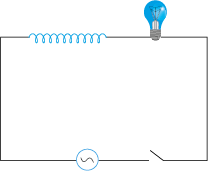A light bulb is rated at \(100~\text W\) for a \(220~\text V\) AC supply. The peak voltage of the source is:
| 1. | \(220~\text V\) | 2. | \(110~\text V\) |
| 3. | \(311~\text V\) | 4. | \(100~\text V\) |
A light bulb is rated at \(100~\text{W}\) for a \(220~\text{V}\) AC supply. The RMS current through the bulb is:
1. \(0.243\) A
2. \(0.454\) A
3. \(0.222\) A
4. \(0.312\) A
A pure inductor of \(25.0~\text{mH}\) is connected to an AC source of \(220~\text{V}\). The RMS current in the circuit is:
(The frequency of the source is \(50~\text{Hz}\))
1. \(20~\text{A}\)
2. \(25~\text{A}\)
3. \(28~\text{A}\)
4. \(32~\text{A}\)
A lamp is connected in series with a capacitor. Predict your observations for dc and ac connections:
| 1. | When a DC source is connected to a capacitor, the lamp will not glow in a steady-state condition. |
| 2. | When an ac source is connected to a capacitor, the lamp will glow. |
| 3. | Both (1) and (2) are correct. |
| 4. | None of these. |
| 1. | When the DC source is connected to the capacitor, the lamp will not glow in a steady-state condition. |
| 2. | When the AC source is connected to the capacitor and the capacitance of the capacitor is reduced, the lamp will glow less brightly. |
| 3. | When the DC source is connected to the capacitor and the capacitance of the capacitor is reduced, the lamp will glow less brightly. |
| 4. | Both (1) and (2). |
A \(15.0~\mathrm{\mu F}\) capacitor is connected to a \(220~\mathrm{V}\), \(50~\mathrm{Hz}\) source. If the frequency is doubled, what happens to the capacitive reactance and the current?
| 1. | the capacitive reactance is halved and the current is doubled. |
| 2. | the capacitive reactance is doubled and the current is halved. |
| 3. | the capacitive reactance remains the same and the current is doubled. |
| 4. | the current remains the same and the capacitive reactance is halved. |
A light bulb and an open coil inductor are connected to an ac source through a key as shown in the figure.

The switch is closed and after some time, an iron rod is inserted into the interior of the inductor. The glow of the light bulb:
1. increases
2. decreases
3. is unchanged, as the iron rod is inserted
4. first increases and then decreases
A resistor of \(200~\mathrm{\Omega}\) and a capacitor of \(15.0~\mu\text{F}\) are connected in series to a \(220~\text{V}\), \(50\) Hz AC source. The voltage (RMS) across the resistor and the capacitor are respectively:
1. \( 160.3 ~\text{V}, 160.3 ~\text{V} \)
2. \( 151 ~\text{V}, 151 ~\text{V} \)
3. \( 160.3 ~\text{V}, 151 ~\text{V} \)
4. \( 151 ~\text{V}, 160.3 ~\text{V}\)
Which one of the following is incorrect?
| 1. | For circuits used for transporting electric power, a low power factor implies large power loss in transmission. |
| 2. | Power factor can often be improved by the use of a capacitor of appropriate capacitance in the circuit. |
| 3. | For circuits used for transporting electric power, a low power factor implies low power loss in transmission. |
| 4. | Both (1) and (2) |
A sinusoidal voltage of peak value \(283 ~\text V\) and a frequency \(50~\text{Hz}\) is applied to a series LCR circuit in which \(R = 3~\Omega,\) \(L = 25.48 ~\text{mH},\) and \(C = 796~\mu\text F.\) The impedance of the circuit is:
1. \(5 ~\Omega\)
2. \(8 ~\Omega\)
3. \(4 ~\Omega\)
4. \(2~\Omega\)


